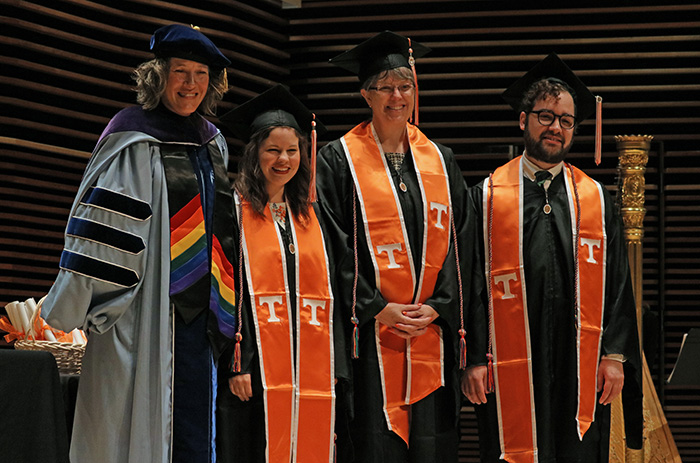SIS D&I Badge Encourages Students to Incorporate Diversity, Equity, and Inclusion Into Their Work

From left: SIS Assistant Professor Carolyn Hank with the 2019 Diversity & Inclusion Badge recipients, Kelsey Collins, Elaine Posanka and Joseph Winberry.
The School of Information Sciences faculty weaves diversity, equity, and inclusion into its curriculum and scholarship, and the SIS community as a whole strives to incorporate it in all other aspects of its operation, such as scholarships, research initiatives, hiring, and training.
“Society continues to confront prejudice, bias, inequities and lack of respect and appreciation. As information professionals committed to integrity, inclusion, accuracy and authenticity, it is imperative we continue to evolve and adopt a critical role at the intersections where people, information and technology meet,” said Assistant Professor Carolyn Hank, who is also the SIS Diversity & Inclusion Officer.
Diversity & Inclusion Badge
The School established the Diversity & Inclusion Badge in 2019 as an honor masters students could receive upon graduation; in order to earn the badge, they must apply and fulfill requirements that include completing research, a scholarly product, or a professional contribution related to diversity and inclusion, during their time as students. Students can earn the badge whether they are on campus or distance education students, as opportunities to promote diversity, equity, and inclusion exist in all communities and settings.
One purpose of the D&I Badge is to encourage students to think about how their work can and should reflect these values.
“Just like ‘Vol means all,’ service in information centers is offered without any limitations on who or what or why. By consciously thinking about inclusion during their coursework, students can start developing that true service mindset, and they can be ready for challenges that come with trying to serve all of their target audiences,” said SIS Clinical Associate Professor Cindy Welch.
Past D&I Badge Recipients Share Their Approach
The badge doesn’t require additional work, it just prompts students to build diversity, equity, and inclusion into existing work they’re already doing. D&I Badge recipient and spring 2020 graduate Leah Cannon said that throughout her time in the program, she looked at her class assignments critically as potential submissions for the D&I Badge, but she also looked outside of class. She volunteered with the Voices Out Loud project, which is intended to archive and elevate historic voices of the East Tennessee LGBTQ+ community, and ended up creating a map and timeline of LGBTQ+ friendly bars and gathering places in the area. She also submitted a project she’s still working on with two other SIS graduate students, which involves delving into identifying barriers within research data management (RDM) and creating a toolkit to help RDM professionals overcome or lessen those barriers.
Cannon also pointed out that the work students do for the D&I badge could help them in their careers after they graduate.
“Lots of jobs require a D&I/equity statement with application materials, and working on projects to meet the D&I badge requirements can demonstrate to an employer how an applicant/candidate has worked with diverse populations and promoted equity,” she explained.
For D&I Badge recipient and spring 2020 graduate Sarah Gonzalez, pursuing the honor came naturally as she was already involved with various groups promoting diversity, equity, and inclusion on the University of Tennessee, Knoxville campus, where she is also an employee. She encourages students who want to pursue the badge to look at their own communities or at the UT campus for opportunities, which are plentiful.
“There are so many diversity projects on campus that need volunteers, and information science can play a part in any project,” she said.
D&I Badge recipient and current PhD student Joseph Winberry agreed with Gonzalez that many of the students who want the badge are often already involved in either professional or volunteer work that fosters the same values. He was working at the Knox County Office on Aging during his first year of graduate school, and wrote a paper about how the KCOA represented diversity among older people in their materials, which he then submitted in a class and used for his badge application. Winberry said students who want the badge should be creative and keep their eyes open for potential diversity, equity, and inclusion opportunities in all of their communities, whether they are volunteer, professional, or academic.
“Diversity and inclusion is about information access and giving people equitable opportunities to live their life to the fullest. That is what made getting the badge—and working towards it—so enriching for me,” he said.